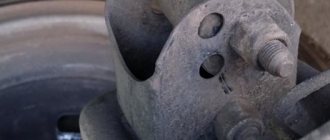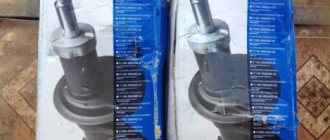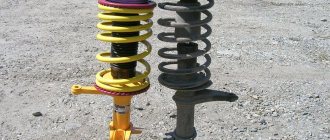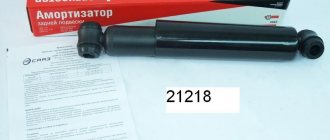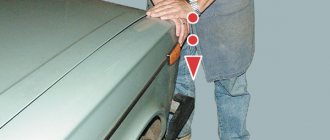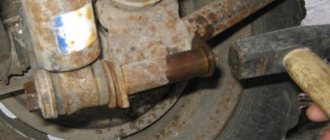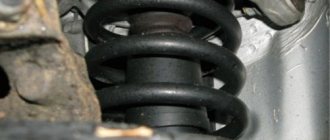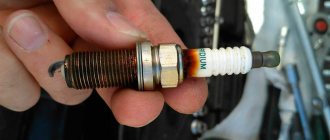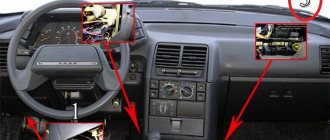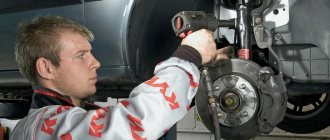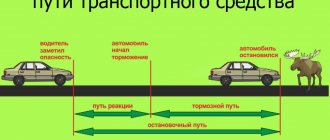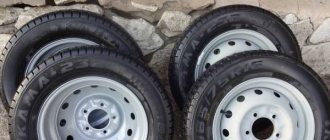Shock absorbers, what they are needed for and where they are installed
When accelerating, the vehicle “squats” backward, unloading the front wheels and loading the rear wheels, which reduces their grip on the road surface. When braking, the opposite is true. In both the first and second cases, the ideal position would be one in which the machine would maintain its normal “horizontal” position.
Approximately the same picture is observed during maneuvering, however, the load here shifts along the sides of the car, and not along the axes.
Shock absorbers keep the wheels in constant contact with the road surface to prevent the driver from losing control of the vehicle. The racks are installed directly next to the car wheels.
What is the difference between gas-oil products and oil products?
From the name itself it is already clear that their main difference is the working composition that is used inside the device.
In oil shock absorbers, the working space is filled with hydraulic oil.
The main disadvantage of these types of devices is aeration (oil foaming), which occurs as a result of changes in the physicochemical properties of the liquid when a piston acts on it in a small space.
This is manifested by a failure in the operation of the device and uncharacteristic sounds.
A partial reduction in aeration is achieved by replacing air with nitrogen gas; as a result, gas-oil analogues have appeared, which come in one or two pipes.
Single-pipe ones are often called gas ones, because there the oil and gas are separated by a movable jumper and do not mix.
IMPORTANT TO KNOW: Causes of shock absorber knocking. Strong backpressure ensures gas pressure in the region of 10 - 30 atmospheres; there are also adjustable analogues
Mainly installed on sports cars
Strong backpressure ensures gas pressure in the region of 10 - 30 atmospheres; there are also regulated analogues. Mainly installed on sports cars.
Twin-pipe gas-oil shock absorbers have less gas pressure - from 3 to 10 atmospheres.
But he won’t delve into the topic, because that’s not what you came here for. The shock absorber structure can be seen in the photo below.
Why do you need to pump?
All new shock absorbers are stored in a lying position, this is convenient and does not take up much space.
A compensation tank is structurally provided inside the product where oil can drain when it is in a horizontal position.
Therefore, if you install a shock absorber that is not pumped, then, as a rule, knocking noises appear immediately or after a while; after a couple of thousand kilometers, working fluid may leak. This is what many inexperienced car owners sin on.
Therefore, the idea is to, after pumping, return the working fluid to the cavities provided for it, and then leave the device in a vertical position until installation, so that overflow does not occur again.
You also need to understand that you can buy shock absorbers, each of which has been in the warehouse for a certain time and this time can vary greatly.
Therefore, you should not worry if the forces exerted on each of them during pumping, as well as the speed of movement of the strut rod to the reverse position, may differ - this is normal.
You also need to understand that if, for example, two shock-absorbing struts on the left or right sides fail, then all devices must be replaced at once, otherwise the car may rock while driving.
Bleeding the shock absorber: why is it done?
Let's start with the fact that today there are several types of shock absorbers, among which the most common and widely used are:
- oil shock absorbers;
- gas-oil shock absorbers;
- gas shock absorbers;
Without going into details, the differences lie in what one or another shock absorber is filled with. In short, oil struts are the softest and most comfortable, while gas struts are the stiffest, but hold the road better. In turn, gas-oil struts represent an average option in terms of rigidity and stability.
You can also note the design features, since the shock absorber can be single-pipe or double-pipe. At the same time, twin-tube shock absorbers are common today; they are installed on the vast majority of cars. For this reason, we will focus on pumping racks of this type.
So, as for the pumping itself, opinions on why it is needed differ somewhat. At the same time, shock absorber manufacturers themselves necessarily recommend bleeding before installing struts on a car!
As a rule, it is generally accepted that bleeding is necessary to remove the air gap from the mechanism. In other words, if there is air in the inner sleeve, the struts will not work normally when driving a car, and the piston shocks can damage the mechanism.
A sign of a problem is that the shock absorber begins to knock. In oil-filled shock absorbers, oil may remain in the inner sleeve, the strut will not function properly after installation and may leak quickly.
However, the widespread opinion about the presence of air in the shock absorber is questioned by many drivers and experts. In fact, to understand why pumping is needed, it is enough to study the information on the official websites of the manufacturers of the racks themselves. For example, below are the recommendations of KYB specialists.
- Bleeding twin-pipe shock absorbers before installation is a mandatory procedure! In double-pipe shock absorbers, the working fluid can flow from the inner to the outer cylinder during storage of the strut, and in parallel, boost gas enters the inner cylinder.
- An under-pumped shock absorber can cause failure of the entire shock absorber piston system, which is a violation of the installation instructions and will void the shock absorber warranty!
In other words, if the strut is not pumped, knocks and noises appear after installation, and the shock absorber valves are destroyed. For this reason, before installation on a car, pumping twin-pipe shock absorbers is necessary in order to bring the struts into working condition (prepare for work), as well as to check their functionality before installation on the car.
For example, during bleeding, you can identify a jammed valve mechanism, as well as other malfunctions. The pumping itself allows the oil and gas to be properly distributed inside the shock absorber.
As mentioned above, during storage and transportation the shock absorber lies, and does not stand as on a car, it can be turned upside down, etc. Of course, the contents of the rack are not distributed properly. In turn, bleeding allows you to eliminate undesirable effects on the valve mechanisms at the very beginning of the car’s movement after replacing the struts.
Why is pumping done?
Not everyone understands why pumping is done and whether it is necessary at all. Some clarity should be provided on this score in order to finally understand the meaning of pumping and the urgent need for such a procedure.
Towbar for Kia Rio: which one to buy and how to install it yourself
Category: Towbars
The working mechanisms of shock absorbers include special sleeves in their design. If air gets inside them, then the device will not be able to return to its original position. Moreover, before installation, air must be removed from new and old parts if you suddenly bought used shock absorbers because their price turned out to be lower. It cannot be ruled out that during the suspension repair process or during troubleshooting, air penetrated inside the mechanism.
We recommend: Diesel fuel additives - what are the best formulations
During storage and transportation, the oil included in the shock absorber penetrates the outer cylinder of the structure, which is why the gas ends up inside the system. This phenomenon leads to the fact that after installing even a new part, a knock is heard.
By performing special actions, excess air is removed from the cylinder. This is done immediately before installation.
And it is still relevant to ask why this is being done. Everything is extremely simple. To ensure correct, efficient and long-term operation of new shock absorbers installed as part of a dependent or independent suspension.
Pumpable types of shock absorbers
Surely you know that shock absorbers are divided into oil, gas and gas-oil. All of them are quite actively used in the design of vehicles.
In this case, pumping is required for all categories of suspension units:
- front shock absorbers;
- rear;
- new parts;
- used;
- original;
- analog;
- single-pipe;
- two-pipe;
- collapsible;
- non-separable.
As you can see, it doesn’t matter what kind of shock absorbers we are talking about. All of them are subject to preliminary pumping before installation. Let you have at your disposal an ordinary old Gazelle or a brand new Audi. Although owners of expensive cars often prefer to have their car serviced at a car service center. But that’s not about that now.
Although it is not fundamentally important whether the shock absorbers are rear and new, or front and used, special attention should be paid to the specific type of element. Gas, oil and gas-oil shock absorbers have their own instructions. Relying on them, you can pump the part with your own hands, and the rack will work for a long time, efficiently and efficiently
Relying on them, you can pump the part with your own hands, and the rack will work for a long time, efficiently and effectively.
Gas shock absorbers
Let's start with pumping these particular shock absorbers. The gas most often used here is nitrogen. It's not difficult to upgrade them. You just need to follow a certain sequence of actions:
Replacing the Renault Logan timing belt: do it yourself or entrust it to a specialist
- Turn the assembly over so that the rod is pointing down toward the floor;
- Now slowly begin to compress the shock absorber;
- After squeezing, hold it in this position for a few seconds;
- Then turn the part the other way around;
- Hold the rod clamped for 4-5 seconds;
- Pull the rod back until it stops;
- Turn the shock absorber over;
- Leave the element in a horizontal position and install it on the car.
At this point, pumping is considered complete. Like I said, nothing complicated. Take your time, but also try not to keep gas-type shock absorbers in a compressed state for more than 6 seconds.
Oil shock absorbers
In the case of such car shock absorbers, the procedure is slightly different.
It is extremely important to strictly follow the given algorithm. The more accurately you follow the instructions, the higher the likelihood of doing everything as correctly as possible.
- Place the shock with the rod down, as in the case of gas elements;
- Smoothly compress the shock absorber until it stops;
- Having completed the compression, do not release the part and hold for 2-3 seconds;
- Without releasing the rod, turn the shock absorber over;
- Hold in a compressed state for up to 6 seconds;
- At this time, the air should come out;
- Then pull the rod out all the way;
- Turn the shock upside down;
- Wait about 3 seconds, and perform similar manipulations at least 3 times.
Although it is believed that the optimal number of such approaches for oil-based automobile shock absorbers is 6.
When you reach the third pumping, be sure to perform the so-called control action. It consists of the following:
- turn the shock absorber so that the rod points upward;
- make several short but sharp compressions of the rod.
In this case, the movement of a properly pumped shock absorber must be as smooth as possible, without dips or jerks. If this occurs, you need to repeat the pumping procedure.
How to bleed a shock absorber
Since each car owner can carry out this operation on his own, spare parts stores often provide instructions on how to correctly carry out this operation and set the required position for installation on the car. First of all, it is necessary to install the shock absorber strut so that the rod is directed upward. After this, using gentle pressure, it is necessary to lower the rod until the surface of the rod is level with the top of the glass. In this position, the rod is fixed for 2-3 seconds, after which it is necessary to smoothly return the rod to its original position.
Checking the quality of the product is carried out as follows: using short movements, the rod must be smoothly lowered and raised. If the shock absorber is fully operational, then these actions will be smooth, without any dips or jerks. If all operations are completed successfully, the new product is ready for installation in the car.
It is worth noting that a monotube shock absorber does not need to be pumped because it contains high-pressure gas inside and is separated by a sealed piston. Thanks to this piston, it is impossible for oil liquid to enter the gas space. However, if the buyer accidentally pumps a shock absorber of this type, it will not cause him any harm; on the contrary, it can contribute to the long service life of the product.
We recommend: Types of additives for restoring an internal combustion engine
If you follow the shock absorber pumping sequence described above, your new shock absorbers will last a long time. This will also help ensure safety when driving on public roads. Removing the air mixture from all shock absorber cavities will prevent damage to the new product. It is advisable to bleed shock absorbers of all types, since it is impossible to cause harm in this way, however, this can prevent breakdowns and ensure long-term operation.
Operating principle
It doesn't matter how the shock absorber is designed. All of them, regardless of type, operate on the same principle
This means that, regardless of type, they need pumping. In the shock absorber chamber, the piston performs a reciprocating movement. The piston has several holes. As the mechanism moves, the pressure in the chamber increases. By the way, it becomes larger when the car moves at low speed.
Bleeding rear shock absorbers before installation
Bleeding is an easy procedure; new shock absorbers do not need to be sent to a service center. To properly pump the device, you need to follow this sequence of actions.
- Install the stand with the stem down. The base must be solid, ideally a concrete floor.
- Smoothly compress the product.
- We fix the position for two seconds.
- To get the rod back, you need to turn the shock absorber over and pull the tube out manually. Usually the rod rises without outside help.
- Leave the rod in the extended position.
- We repeat the procedure two or three more times.
After this, the rear struts can be installed on the lever or axle of the car.
How to work with gas oil
Help: The spelling “gas-oil” is erroneous. That’s right: “gas-oil.”
Gas-oil shock absorbers must also be pumped before installation, whether new or used.
- The stand must be turned into a vertical position with the cylinder facing up.
- It is necessary to compress the shock absorber and hold it in this position for several seconds. Hold the shock absorber in the lowered position for several seconds
- Next, the shock absorber turns over, but must be in a compressed position.
- The cylinder is pulled out very slowly to its original position. Smoothly pull the cylinder up
- The procedure should be performed 3-4 times at short time intervals - no more than a few seconds.
After bleeding, do not turn the shock absorber over, otherwise you will need to perform the procedure again. If you hear a slight slurping sound when you press the body, don’t worry. This is not a malfunction.
How to pump such shock absorbers (video)
https://youtube.com/watch?v=-9JfmTW1ldM
If all actions are performed correctly, there should be no knocks or other extraneous sounds. Otherwise, the procedure should be repeated. If you cannot bleed the shock absorber yourself, you should contact a specialized service. There are many devices, stands, attachments and other special equipment for high-quality performance of the procedure.
What is needed to pump racks correctly
Any shock absorbers need to be pumped:
- front and rear,
- new and contract,
- one- and two-pipe,
- collapsible and non-collapsible.
The pumping process is not difficult. No special tools required. Just gloves will be enough to protect your hands from injuries and dirt. First, you should familiarize yourself with the general rules for its implementation:
- after completing the procedure, until the very moment of installation in its place, it is necessary to keep the part vertically - otherwise air may again get into it;
- It is important to consider the need to drain oil from some shock absorbers.
Shock absorbers can be either single- or double-tube, and there are also struts with a remote chamber
You can perform draining in different ways:
- by sinking the piston into the lower component of the part (there should be an undercompression of approximately 3 cm);
- through a groove designed for this purpose - it is usually present in the upper part of the part.
Instructions for installing oil and gas-filled shock absorbers
To ensure that your shock absorbers last as long as possible, we recommend following the rules below:
1. Immediately before installing the shock absorber, it must be pumped as follows:
- turn the shock absorber upside down and wait 3 - 5 seconds;
- Slowly compress the shock absorber all the way and wait 3-5 seconds;
- holding the shock absorber in a compressed state, turn it over to the working position and wait 3-5 seconds;
- after this, let the rod come out (for gas-filled shock absorbers); for oil shock absorbers, it must be pulled out for the entire working stroke
- procedure 1-4 should be repeated several times until the failure completely disappears when the shock absorber is operating on rebound (point 4).
2. It is necessary to use a special tool to hold the rod from turning to prevent damage to the chrome plating.
To do this, it is prohibited to use pliers, a gas wrench or other tools not intended for these purposes, because worn chrome plating of the rod can lead to disruption of the shock absorber's operating functions.
Soon this defect will lead to wear of the oil seal and rod guide. This, in turn, leads to oil leakage and reduced shock absorber service life.
3. Shock absorbers should only be tightened after the vehicle is on its wheels, or when the wheels are raised with a transmission jack or similar equipment to level the shock absorber mounting locations.
4. It is unacceptable to use pneumatic tools to install shock absorbers. Using such tools may result in the threaded part of the shock absorber rod breaking off.
5. It is necessary to use a torque wrench (wrench with a torque limiter) when tightening threaded connections to maintain the tightening torque; overtightening the nuts and bolts can damage the fasteners and can cause premature failure of the shock absorber.
When operating a car in the winter, after a long period of parking, it is necessary to drive the first 500 meters at a speed of no more than 30 km/h to warm up the oil in the shock absorbers to operating temperature.
based on materials from the site: https://www.4x4sport.ru/publications.html?publications=publications20
» data-medium-file=»https://i2.wp.com/avtoivan.ru/wp-content/uploads/2018/09/dinamometricheskij-klyuch.jpg?fit=300%2C168″ data-large-file= »https://i2.wp.com/avtoivan.ru/wp-content/uploads/2018/09/dinamometricheskij-klyuch.jpg?fit=960%2C539″ data-lazy-src=»https://i2. wp.com/avtoivan.ru/wp-content/uploads/2018/09/dinamometricheskij-klyuch.jpg?fit=960%2C539″ data-lazy-srcset=”https://i2.wp.com/avtoivan.ru /wp-content/uploads/2018/09/dinamometricheskij-klyuch.jpg?w=960 960w, https://i2.wp.com/avtoivan.ru/wp-content/uploads/2018/09/dinamometricheskij-klyuch. jpg?resize=300%2C168 300w, https://i2.wp.com/avtoivan.ru/wp-content/uploads/2018/09/dinamometricheskij-klyuch.jpg?resize=768%2C431 768w" data-lazy- sizes=”(max-width: 960px) 100vw, 960px” />
We pump original oil shock absorbers of Lada Priora
These bleeding methods are suitable for most shock absorber struts installed on domestic cars, including the VAZ 2107.
Doing the work manually is not easy, but it is possible. Please note that the front shock absorbers on the Priora are not replaceable and those from other models, especially the VAZ 2110, are not suitable, they have different springs.
There are two methods of pumping, without turning over and with turning over the shock absorber strut.
But there are general recommendations that must be followed in all cases.
- When pumping, the shock absorber should be in a vertical position, and if tilted, then no more than a few seconds;
- Bleeding must be carried out immediately before installation on the car;
- Do not use a tool that can damage the product (gas wrench, hammer, pliers), hydraulics is a delicate matter, remember this;
- Do not allow the rod to rotate in the stand itself around its axis;
- Apply efforts smoothly, without jerking;
- An already pumped shock absorber must be in a vertical position at all times.
Method 1
Place the shock absorber strut on a level place with the lug facing down.
The task is to fully extend the rod when pumping at least 10 times and return it back, thereby ensuring that the liquid (oil) evenly fills the working space.
It is difficult to pull the rod out by hand, so they come up with different devices.
In our case, you can take a 30mm adjustable wrench with a hole in the handle whose diameter just allows you to use the tool as a lever.
Place the key on the rod so that the threads do not touch and take it to the break.
Do not sharply, using even force, pull it out until it stops.
We return it back smoothly, without any jerks.
The latter should go down easier than up, the ideal case is when the lowering occurs under its own weight. But if the rod does not fall without influence on it, this is not scary.
The design and principle of operation of a car shock absorber
So, what is a shock absorber and what is it for? When driving over bumps, different forces act on the wheels of the car. These forces are transmitted to the car body using springs and a system of suspension arms. A significant part of the forces is absorbed by springs and suspension arms. But every action has a reaction.
For example, a car wheel ran over a bump, the spring compressed (that is, it took the impact and accumulated energy) and you felt almost nothing. But the spring is already compressed and it must deflate, and having done this, it will give off part of the accumulated energy to the car body, simply throwing it up.
Having thrown the body up, the spring is without load and pulls the wheel upward, trying to tear it off the road. This will happen exactly until the moment the car body again begins to put pressure on the spring and, accordingly, on the wheel. At this moment, the wheel practically does not touch the road, and you risk losing control.
The body, having pressed on the spring and pressed the wheel to the road, again compressed the spring, which had accumulated energy, and which in a split second would certainly begin to decompress, and the whole cycle would begin again. And this will continue until the vibrations die out. But as soon as the vibrations die out, another bump in the road will definitely appear and everything will begin with renewed vigor.
In order to prevent rocking of the car body, as well as to prevent the transfer of compression energy from the spring to the car body, shock absorbers are used. These devices do not allow spring vibrations to occur during decompression, and if they do occur, they are quickly damped.
In this article I will not go into ancient times (by automotive standards) and talk about friction-type shock absorbers. I’ll start my story with shock absorbers that are widespread everywhere - these are hydraulic shock absorbers.
Today, two types of hydraulic shock absorbers are used in cars - single-tube and double-tube. Or as they are also popularly called oil, gas-oil and gas. Which is not entirely true, because at the moment there are practically no oil shock absorbers left on the market. The vast majority of modern shock absorbers are gas-oil. And they differ in design - single-pipe and double-pipe. Gas shock absorbers are used under increased loads, for example in motorsports, and are several times more expensive than gas-oil shock absorbers.
So, next we will talk about gas-oil shock absorbers, which we will divide into single-pipe and double-pipe.
Replacement or repair? What you can do yourself
Deciding what to do is not easy. First of all, you need to find out whether the stand can be disassembled or whether it has a non-demountable design. If the case is monolithic, then repairs are unacceptable - if you open the case, the part will not work.
If a nut or retaining ring is installed in the place where the rod enters the pipe, then the rack can be serviced and repaired.
How to restore gas
First of all, the part is clamped in a vice in a vertical position. Next, it is very important to clean the element well, and also to thoroughly blow out the place where the rod goes with air from the compressor. Then the assembly is disassembled - the protective cap on the rod is removed.
Next, a special fitting is put on the rod, allowing gas to be pumped in. Gas is pumped until the required pressure is reached - when performing this operation, you need to remember about safety. The procedure is carried out several times until the desired pressure is achieved. To control the pressure you need a pressure gauge.
Note: Symptoms and signs of crankshaft sensor malfunction and checking it
When the procedure is completed and the pressure corresponds to the specified pressure, lubricate the stem seal and put the cap on the body. This repair technology is suitable for gas and gas-oil shock absorbers.
Replacement of valves, stems, seals
First you need to disassemble the shock absorber. The rod and piston, valves and sealing rings are removed and checked. Bad elements change. Rubber elements can be selected from universal ones in the markets. Metal parts can be made by a turner.
Next, the assembly is carefully assembled, tracking the sequence of installation of parts. It is important to pay attention to cleanliness during assembly. If dirt or hard metal particles get inside, the repaired unit will fail.
Particular care should be taken when troubleshooting valves. Their proper operation depends on the characteristics of the shock absorber. You can adjust the softness by changing the rod washers. To do this, it is better to refer to the manufacturers’ instructions, since there are no universal solutions.
On the subject: How to check the pressure in a car's air conditioner yourself
All that remains is to install the rod into the pipe and replace the seal. It happens that the oil seal is in excellent condition. Then a new grease is added to it and used further.
Then new oil is poured into the mechanism to the top. During the installation of the rod, excess will leak out. There is no need to be afraid of excess oil consumption. The main task here is that air should not get into the chamber in any way... Then the rack needs to be pumped.
How to bleed a shock absorber
The stand is installed so that the rod faces up. Then, without jerking, the rod is smoothly compressed until the working part of the rod reaches 2 cm from the upper edge of the glass. The rod is fixed in its current position for a few seconds.
Then the rod is also smoothly pulled out to the fully expanded position. This algorithm is repeated several times – usually 3 times is enough.
Tips for replacing shock absorbers
However, shock absorber manufacturers offer a number of tips to help you replace them correctly and quickly. For example, the manufacturers of KYB and Kayaba recommend adhering to the following recommendations:
- When bleeding the shock absorber, do not use any additional tools to hold the rod in order to avoid damage to the seal and possible premature leakage of fluid;
- do not use pneumatic tools to tighten the rod nut;
- It is highly undesirable to use old boots when replacing the original shock absorber,
- gaskets and shape washers;
- shock absorbers should only be installed in pairs;
- Before fixing the upper mounts, you must make sure that the car rests freely on four wheels and all jacks and stands have been removed.
Thus, it is necessary to prepare the shock absorber for use when replacing it, and if you take into account the manufacturer’s recommendations, the unit will last a long time and without problems. Smooth roads to all!
How to bleed racks before installation - step-by-step instructions
Today there are the following types of shock absorbers:
- gas (most often using nitrogen);
- oil;
- gas-oil.
The process of performing a procedure of this type for each variety is associated with some significant features. Familiarization with them is mandatory. If mistakes are made, the working part will quickly fail during intensive use of the car, which threatens early repairs.
Before we get started, I advise you to read our recent article, which discussed the front shock absorber struts. I'll leave the link here. Go ahead, read, get new useful information.
Pumping is considered a key condition for proper installation and further effective operation of the unit. If you do not do this, the part will fail. Moreover, such a malfunction does not fall under the terms of the warranty case. Everything will have to be corrected at your own expense.
The condition of roads in the post-Soviet space is far from the best. This is confirmed by the need to regularly replace shock absorbers on cars. If the operation is carried out at a service station, then there are no problems with this. For those who decide to carry out repairs themselves, you need to know how to perform this operation correctly.
Varieties If a car enthusiast knows what shock absorbers he knows, then we will get something like this: oil, gas-oil and gas. This answer is partially correct. It is more correct to divide into two types: oil and gas. This division is based on the use of different working substances.
Gas shock absorbers use an inert gas, most often nitrogen, pumped under high pressure. In oil shock absorber struts, hydraulic oil and air or gas are pumped into the working space. Structurally, they are divided into two types: two-pipe and single-pipe. The first type of shock-absorbing struts is the most common due to its simplicity and low cost of manufacture.
Oil or gas and oil are used as the working substance. The main disadvantage of oil shock absorbers is poor cooling of the working substance. The oil gets very hot due to its small working volume. High temperatures cause the oil to foam and the shock absorber stops working correctly.
Wait 3–5 seconds. 3. Turn the shock absorber over. Wait 3-5 seconds.4. Extend the rod smoothly to 3/4 of the length. Wait a couple of seconds.5. Turn the shock absorber over and press the rod in again.6. Repeat steps 2–5 from three to six times. After the third swing, check. In this case, you need to sharply press the rod several times - it should move smoothly without jerking.
All new gas-oil shock absorbers must be pumped before installation.
Many manufacturers produce shock absorbers, so the range of these parts on the market is wide. Spare parts perform well, are quite reliable and durable. Moreover, installing gas-oil shock absorbers from an expensive brand is not always advisable. You don't have to overpay to get a good product. As an example, consider shock absorbers produced by the Deqst brand.
This manufacturer offers a wide range of products for different brands and models of cars. The parts are made using innovative technology aimed at achieving maximum comfort when operating the machine. If you want to know more about the qualities of gas-oil shock absorbers, you can read what reviews car enthusiasts write about Deqst spare parts. This new and little-known brand on the Russian market is rapidly gaining popularity due to the optimal combination of high quality parts and reasonable prices.
Even if you bought an expensive and high-quality shock absorber, it can quickly fail and not perform its functions due to improper installation. Here you need to act strictly according to the instructions.
Varieties
If a car enthusiast knows what shock absorbers he knows, then we will get something like this: oil, gas-oil and gas. This answer is partially correct. It is more correct to divide into two types: oil and gas.
This division is based on the use of different working substances. Gas shock absorbers use an inert gas, most often nitrogen, pumped under high pressure. In oil shock absorber struts, hydraulic oil and air or gas are pumped into the working space.
Structurally, they are divided into two types: two-pipe and single-pipe.
The first type of shock-absorbing struts is the most common due to its simplicity and low cost of manufacture. Oil or gas and oil are used as the working substance. The main disadvantage of oil shock absorbers is poor cooling of the working substance. The oil gets very hot due to its small working volume. High temperatures cause the oil to foam and the shock absorber stops working correctly.
Shock absorbers are structurally made into two-pipe and single-pipe. Oil and gas are pumped into the middle
Gas-oil shock absorber struts are partially free of this drawback. Oil and air are pumped into a two-pipe housing under a pressure of 2–3 atmospheres. Sometimes nitrogen is used instead of air. This solution reduces the likelihood of aeration - foaming of the oil.
This is interesting: Apple has taught iOS 7 to connect to machines
Structurally, monotube shock absorbers do not have a working chamber. It is replaced by the rack housing. The tube is divided into two sections. The upper part is filled with oil, and the lower part is filled with high pressure gas. There is a valve between the sections.
Gas shock absorbers are of particular interest to drivers. This is no accident. Gas struts are primarily used in motorsports. For sports driving, this type of rack is most often chosen. The operation of the gas shock absorber is ensured by pumped gas under high pressure. Such racks are the toughest and driving on city roads is accompanied by shocks and impacts. Such a ride cannot be called comfortable, but driving will be clear and controlled. Therefore, gas shock absorber struts are used mainly on racing cars.
A special type of shock absorbers are the so-called “reversals”. They were given this name not because they can be placed upside down. In such racks, the reverse position of the rod is used. In conventional shock absorbers, the rod is directed upward. In inversions, the rod is directed downwards and is attached to the shock-absorbing strut body. There is a pseudo-rod on top. It looks much thicker. The operation of the inverted shock absorber is ensured by several plain bearings. This design reduces the vertical and lateral load on the rack.
